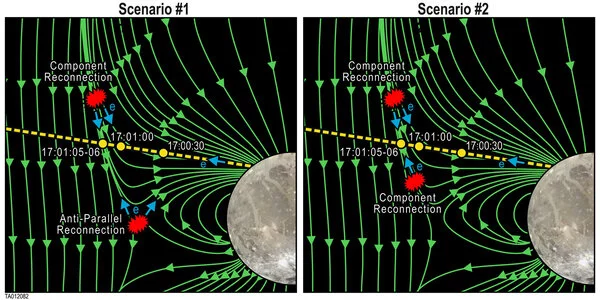Magnetic reconnection is a process that occurs when the magnetic field lines of two different magnetic fields come together and interact in such a way that they “reconnect” with each other, changing their shape and releasing a large amount of energy. It’s a phenomenon that is commonly observed in space, particularly in the Earth’s magnetosphere.
NASA’s Juno spacecraft flew close to Ganymede, Jupiter’s largest moon, in June 2021, looking for signs of magnetic reconnection. A team led by Southwest Research Institute examined electron and ion particles as well as magnetic fields as Jupiter and Ganymede’s magnetic field lines merged, snapped, and reoriented, heating and accelerating the charged particles in the region.
“Ganymede is the only moon in our solar system that has its own magnetic field,” said SwRI’s Juno Principal Investigator Dr. Scott Bolton. “The magnetospheric fireworks are caused by the snapping and reconnecting of Ganymede’s magnetic field lines with Jupiter’s.”
Magnetic reconnection is an explosive physical process that converts stored magnetic energy into kinetic energy and heat. Ganymede’s mini magnetosphere interacts with Jupiter’s massive magnetosphere, in the magnetopause, the boundary between the two regions.
Ganymede is the only moon in our solar system that has its own magnetic field. The magnetospheric fireworks are caused by the snapping and reconnecting of Ganymede’s magnetic field lines with Jupiter’s.
Dr. Scott Bolton
“We interpreted the presence of accelerated electrons traveling along the magnetic field at Ganymede’s magnetopause as evidence that magnetic reconnection was occurring there during the Juno flyby,” said Dr. Robert Ebert, lead author of a Geophysical Research Letters paper describing the findings. “These findings support the idea that magnetic reconnection at Ganymede’s magnetopause can be a driver of dynamic processes in the local space environment around this Jupiter moon.”
The SwRI-developed Jovian Auroral Distributions Experiment (JADE) aboard Juno observed enhanced electron fluxes, including accelerated, magnetic field-aligned electrons. Juno’s observations of reconnection are thought to be related to the generation of Ganymede’s aurora.
In the case of Ganymede and Jupiter, Ganymede is the largest moon in the solar system and has its own magnetic field. Jupiter, on the other hand, has a massive magnetic field that is about 20,000 times stronger than the Earth’s. When the two magnetic fields interact, they can create a region of intense activity that includes magnetic reconnection.

“The accelerated electrons observed by JADE are similar to those observed by NASA’s Magnetospheric Multiscale (MSS) spacecraft during reconnection at the Earth’s magnetopause,” said Dr. Stephen Fuselier, a co-author of the paper. “That’s one of the exciting results from the Ganymede flyby: Despite the vast differences between Ganymede and Earth, we find commonality in the universal process of magnetic reconnection.”
The SwRI-led Ultraviolet Spectrograph (UVS) observed Ganymede’s auroral emissions during the Juno flyby, which are expected to be produced by electrons accelerated by magnetic reconnection. SwRI has built two additional UVS instruments for use in Jupiter orbit aboard the ESA’s Jupiter ICy moons Explorer (JUICE) and NASA’s Europa Clipper spacecraft. The JUICE mission of the European Space Agency is scheduled to launch in April 2023 and arrive at Jupiter in 2031. The Europa Clipper mission from NASA is set to launch in October 2024 and arrive at Jupiter in 2030.
“Nothing is simple – or small – when you have the biggest planet in the solar system as your neighbor,” said Thomas Greathouse, a Juno scientist from SwRI. “This was the first measurement of this complicated interaction at Ganymede. This gives us a very early tantalizing taste of the information we expect to learn from ESA’s JUICE mission.”
This discovery is important because it helps us better understand the complex interactions between the magnetic fields of planets and their moons. It also has implications for the search for life beyond Earth, as moons like Ganymede are thought to be potentially habitable environments. Understanding the magnetic activity in these environments is crucial for determining their habitability.
















